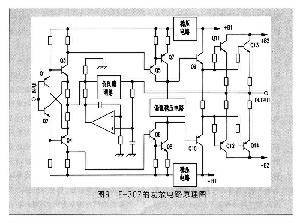In the circuit of Fig. 6, the "input-side DC servo" circuit composed of A1 and its peripheral components is also regarded as a "classic design" of the golden voice in the power amplifier circuit. It has been used for reference by many manufacturers' amplifier products. The input end of this output DC potential servo circuit is connected to the output end of the large circuit. After the audio signal is filtered by the low-pass filter circuit, the DC potential change of the output end can be detected, and the control voltage is amplified and output to the power amplifier through A1 At the front end of the circuit, correct the potential at the output to keep it normal at all times.
The setting of the signal input interface of the E-408 amplifier is also more elaborate. In addition to general unbalanced audio input interfaces, two sets of balanced input interfaces are also provided, including a set of CD balanced input interfaces and a set of balanced input interfaces. This balanced input interface can be connected to a signal source device with a balanced output, such as some advanced CD players or other audio source devices. The use of balanced transmission can eliminate some "common mode" interference, improve the signal-to-noise ratio and improve playback sound quality.
2. Circuit characteristics of E-307 amplifier
Figure 9 is a schematic diagram of the E-307 power amplifier circuit. From the picture, the power amplifier circuit of this amplifier can be said to be the "standard" design of Golden Voice, and it is also a very mature and excellent circuit. It has been used for reference by amplifier products of many foreign manufacturers. The input circuit of this amplifier adopts a fully symmetrical cross-coupling configuration (this circuit is a simplified circuit, and some circuits need to include constant current sources and other circuits). It has the characteristics of wide dynamic range, good linearity, and extremely low noise. The emitters of Q3 and Q4 are also added with large loop negative feedback and the control signal of the output end servo circuit, in order to improve the linearity of the entire amplifier circuit and stabilize the working state of the amplifier. This circuit is also the same as the E-408 power amplifier circuit, and uses the "current negative feedback" method of Golden Throat in order to improve the phase characteristics of the feedback signal and finally get a purer music signal output.

The output stage of this machine's power amplifier circuit uses two pairs of high-power output tubes dedicated for audio in parallel output. According to reports, this high-power output tube uses a specially designed "multi-emitter" structure that can provide instantaneous high current output and drive capability. Very good, linear is also good, can ensure sufficient output dynamics and strength.
Many aspects of the E-307 amplifier circuit are similar to the E-408, and they all use the mature technology of Golden Voice. For example, the front-end tone control circuit of this machine also uses Golden Voice's "additive active filter tone control" circuit, and the sound source selection circuit also uses a "logic control relay" design; the input interface settings also include two sets of balanced inputs Interface (CD input and line input), as well as the use of "plug-in box" and additional plug-in methods to expand the input signal mode. This machine can also insert DAC-10 digital signal input plug-in, AD-10 analog phono input plug-in and LINE-10 line input plug-in in the plug-in box behind the machine.
It is worth noting that the two combined amplifiers of Golden Voice are designed to work in Class AB, but after actual audition, they feel that the sound quality of the playback is soft, warm and mellow, which is quite characteristic of the sound quality of Class A amplifiers. This also reflects the profound "knowledge" of Golden Throat Amplifier in design and production. This may give our fans a little inspiration, let us think about whether Hi-Fi must choose (made or purchased) Class A amplifier!
Figures 3 and 4 are photos of the internal structure layout of E-408 and E-307, respectively. It can be seen from the photos that the two amplifiers of Golden Voice are designed as separate components for each channel of the post-stage amplifier (see the upper part of Figure 3 and Figure 4). Each power amplifier is supported by a radiator, and each channel The high-power output tube (E-307 is two output tubes, E-408 is three output tubes) is installed close to the radiator, and the post-stage circuit board is designed to be combined with the radiator. This design not only makes the high-current transmission path of the subsequent stage more simple, but also facilitates the installation and debugging of the whole machine. The whole post-stage amplifier is located in the central part of the whole machine, located on both sides of the power transformer, and separated from the rest of the surrounding circuits with metal plates. This layout can not only completely separate the back-stage high-power circuit from the front-stage circuit, sound source selection and external input plug-in box, but also make the weight distribution of the whole machine more balanced, which is more conducive to reducing the vibration and interference of the chassis. In the circuit design, in order to completely separate the pre-amplifier and the post-amplifier circuit to avoid mutual interference and influence, the power supply circuit is also independent, and a good voltage regulator circuit is provided for the pre-amplifier . Even when the power amplifier circuit is working in a large signal and high current state, the pre-amplifier can still get a stable power supply, and various interference pulses in the power supply are also filtered out.
Second, the circuit characteristics of E-408 and E-307
1. Circuit characteristics of E-408 amplifier
The amplifier circuit of Golden Voice also has its unique features, such as the topology technology using MCS multiple input circuits in parallel addition, and the current feedback amplifier circuit; the active tone circuit is used in the tone control circuit of the previous stage. Fig. 5 is the schematic diagram of the pre-stage circuit of the E-408 amplifier, and Fig. 6 is the schematic diagram of the E-408 power amplifier circuit.

Most of the power amplifier circuits of Golden Throat use current feedback amplifier circuits, so here we briefly introduce the basic principles of this current feedback amplifier. Common power amplifier circuits mostly use voltage feedback to compensate the linearity of the amplifier circuit, and improve the dynamic internal resistance and damping characteristics of the power amplifier output. Because the phase shift will not be avoided in the voltage feedback circuit, affecting the output waveform of some components in the feedback signal, it will also affect the purity of the output audio signal. In the current feedback circuit used in the golden throat amplifier, after the input audio voltage signal is processed by the input buffer, it can be converted into an audio current signal and sent to a current adder; in this current adder, the feedback network is also input. The audio current of the final current output circuit sent. Because these circuits work in a very low impedance state, it is not easy to produce phase distortion, and can maintain the phase accuracy of the original signal. After passing through an IV converter, the audio current output by the current adder is converted into an audio voltage signal to drive the output amplifier. In general power amplifier circuits, large loop feedback is often distorted due to signal phase shift. This current feedback circuit can better solve this problem and improve the fidelity of the amplifier circuit.
The input stage in the circuits of Figures 5 and 6 uses the unique MCS multiple input circuit of the Golden Throat and the parallel addition topology circuit. This input stage circuit uses two input amplifiers of the same configuration (Q1a, Q2a, Q3a in the figure) The fully symmetrical cross-coupled amplifier circuit composed of Q4a is connected in parallel with another amplifier of the same configuration composed of Q1b, Q2b, Q3b, and Q4b. This can improve the signal-to-noise ratio of the input stage and increase the fidelity and improve the integration. The sound quality of the player. According to tests, this MCS input circuit using the above two input circuits in parallel can improve the signal-to-noise ratio by about 3dB.
The pre-amplifier of Golden Throat often uses an active filter circuit for tone control. The principle of this active filter circuit has been introduced in the past. The active filter tone control circuit used by this amplifier is called "additive active filter tone control" circuit. In fact, this is to connect a high-pass filter and a low-pass filter to the feedback loop of an inverting amplifier, and the potentiometer to adjust the tone boost and attenuation is a special potentiometer with a center tap. When the tone control potentiometer is in the flat characteristic position, the potentiometer arm end is just grounded. At this time, it is equivalent to that neither the high-pass nor the low-pass filter is connected to the feedback loop, which does not affect the flat characteristic of the original circuit. But when you need to boost or attenuate the high and low bass, the filter is connected to the feedback loop, you can change the frequency characteristics of the circuit as needed. This tone control circuit of Golden Throat has quite precise lifting and attenuation characteristics, and will not affect the purity of the audio signal.
According to reports, the sound source selection circuit of the E-408 amplifier is a "logic control relay" type design. As can be seen from the photo in Figure 7, the relay of this sound source selection circuit is directly mounted on the audio input interface circuit board, so that the input sound source signal can be input to the pre-amplifier circuit after being selected by the relay. The sound source selection switch for controlling the sound source selection relay is installed on the left side of the front panel, which is convenient for the user's operation control. The design of the E-408 amplifier that uses relays to convert can use DC power to control the work of the relay. The DC control signal introduced to the audio input circuit board will not interfere with the audio source input circuit. If the multi-gear switch is used to convert the sound source signal directly, the input signal of the sound source must be connected to the front panel with a long transmission line, and then input to the pre-amplifier circuit after the switch selection, so it is very easy to introduce interference and noise. If an electronic switch is used to convert the input signal of the sound source like a general AV amplifier, obviously the distortion of the signal and the introduction of noise will also be caused by the dynamic, noise or nonlinear effects of the electronic switch.
Three, E-408 and E-307 amplifier materials research
Gold Throat's amplifier products have always been quite elaborate in terms of materials, and of course this is commensurate with its high price. Many audio enthusiasts know that the volume potentiometer used in the original model of the golden throat amplifier was introduced a few years ago. The shape of the potentiometer using a metal casting shell is much larger than the general potentiometer. The diaphragm and brush used are also specially made, and the structure of the potentiometer is also very different. The design of fixed brush and rotating diaphragm is used to ensure the stability of its work. It is said that the potentiometer of Golden Throat can guarantee that during the normal working life of the amplifier, there will be no bad contact or rotating noise. However, the price of this potentiometer is more than 1,000 yuan, which is equivalent to the price of buying an amplifier in the Chinese. At present, the newly designed motor-controlled potentiometer used in the new golden throat amplifier (available for remote control of volume, although it is not as bulky as the old model, its structure is similar to the general "universal" potentiometer, but it is also specially made according to the introduction , Its reliability is very high, and it can also ensure that it works reliably in the amplifier without poor contact or rotating noise.
As mentioned earlier, the power output tubes of these two amplifiers are special high-power tubes specially designed for "multi-emitter" high-current audio. This kind of power output tube printed with Accuphase logo is estimated to be customized by the Jinsheng subsidiary looking for semiconductor manufacturers (OEM), which has high reliability and good linearity of amplification. The power supply circuit also uses a fully shielded high-quality transformer with a large amount of power surplus, and a special large-capacity power supply filter capacitor. Among them, the E-307 amplifier uses a 500VA common structure transformer, and the filter capacitors are two 22000µF high-quality capacitors; the E-408 amplifier uses 600VA high-quality toroidal transformers, and the filter capacitors are two 33,000µF high-quality capacitors. The speaker terminal used by the amplifier is a large terminal made of high-purity oxygen-free copper, and the contact surface is gold-plated to ensure that the speaker line can be firmly connected when the box is connected; the amplifier is provided with two groups of speaker terminals A and B. It can be used to connect the speaker to play with "two-wire connection". In addition, the chassis, structural parts, heat sinks, power cords, switches and other parts and components of these two amplifiers are of good quality and well-made.
4. The main technical indicators of E-408 and E-307
Rated output power: (both channels are driven simultaneously, within the range of 20Hz ~ 20kHz)
Total harmonic distortion: (both channels are driven simultaneously, within the range of 20Hz ~ 20kHz, and the load is 4Ω ~ 16Ω)
Intermodulation distortion: E-408 and E-307: both better than 0.01%;
Frequency response: When the input is high level and the average output power is continuous,
High level input, when the output power is 1W,
Damping coefficient: load 8Ω, 50Hz,
E-408: 120; E-307: 100;
Signal to noise ratio: high level input, A weighting,
Balanced input, A weighting,
After the amplifier, A weighting,
Front stage output: when the load is 50Ω,
Overall gain: from high-level input terminal to power amplifier output,
After the amplifier gain,
Overall volume and weight:
Gold Throat's amplifier products have always been quite elaborate in terms of materials, and of course this is commensurate with its high price. Many audio enthusiasts know that the volume potentiometer used in the original model of the golden throat amplifier was introduced a few years ago. The shape of the potentiometer using a metal casting shell is much larger than the general potentiometer. The diaphragm and brush used are also specially made, and the structure of the potentiometer is also very different. The design of fixed brush and rotating diaphragm is used to ensure the stability of its work. It is said that the potentiometer of Golden Throat can guarantee that during the normal working life of the amplifier, there will be no bad contact or rotating noise. However, the price of this potentiometer is more than 1,000 yuan, which is equivalent to the price of buying an amplifier in the Chinese. At present, the newly designed motor-controlled potentiometer used in the new golden throat amplifier (available for remote control of volume, although it is not as bulky as the old model, its structure is similar to the general "universal" potentiometer, but it is also specially made according to the introduction , Its reliability is very high, and it can also ensure that it works reliably in the amplifier without poor contact or rotating noise.
As mentioned earlier, the power output tubes of these two amplifiers are special high-power tubes specially designed for "multi-emitter" high-current audio. This kind of power output tube printed with Accuphase logo is estimated to be customized by the Jinsheng subsidiary looking for semiconductor manufacturers (OEM), which has high reliability and good linearity of amplification. The power supply circuit also uses a fully shielded high-quality transformer with a large amount of power surplus, and a special large-capacity power supply filter capacitor. Among them, the E-307 amplifier uses a 500VA common structure transformer, and the filter capacitors are two 22000µF high-quality capacitors; the E-408 amplifier uses 600VA high-quality toroidal transformers, and the filter capacitors are two 33,000µF high-quality capacitors. The speaker terminal used by the amplifier is a large terminal made of high-purity oxygen-free copper, and the contact surface is gold-plated to ensure that the speaker line can be firmly connected when the box is connected; the amplifier is provided with two groups of speaker terminals A and B. It can be used to connect the speaker to play with "two-wire connection". In addition, the chassis, structural parts, heat sinks, power cords, switches and other parts and components of these two amplifiers are of good quality and well-made.
4. The main technical indicators of E-408 and E-307
Rated output power: (both channels are driven simultaneously, within the range of 20Hz ~ 20kHz)
E-408: 260W × 2 (4Ω), 220W × 2 (6Ω), 180W × 2 (8Ω);
E-307: 140W × 2 (4Ω), 120W × 2 (6Ω), 100W × 2 (8Ω);
Total harmonic distortion: (both channels are driven simultaneously, within the range of 20Hz ~ 20kHz, and the load is 4Ω ~ 16Ω)
E-408: better than 0.02%;
E-307: better than 0.01%;
Intermodulation distortion: E-408 and E-307: both better than 0.01%;
Frequency response: When the input is high level and the average output power is continuous,
E-408 and E-307: 20Hz ~ 20kHz, + 0dB, -0.2dB;
High level input, when the output power is 1W,
E-408 and E-307: 2Hz ~ 150kHz, + 0dB, -3dB;
Damping coefficient: load 8Ω, 50Hz,
E-408: 120; E-307: 100;
Signal to noise ratio: high level input, A weighting,
E-408: 113dB, E-307: 104dB;
Balanced input, A weighting,
E-408: 92dB; E-307: 88dB;
After the amplifier, A weighting,
E-408: 129dB, E-307: 122dB;
Front stage output: when the load is 50Ω,
E-408: 1.58V; E-307: 1.13V;
Overall gain: from high-level input terminal to power amplifier output,
E-408 and E-307: 20dB;
After the amplifier gain,
E-408 and E-307: 28dB;
Overall volume and weight:
E-408 is 475mm × 180mm × 422.7mm, and the weight is 23.4kg;
E-307 is 475mm × 170mm × 425mm, and the weight is 21.6kg.

Follow WeChat
Interesting and informative information and technical dry goods

Download Audiophile APP
Create your own personal electronic circle

Follow the audiophile class
Lock the latest course activities and technical live broadcast
comment
Publish
related suggestion
